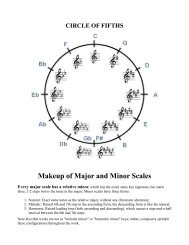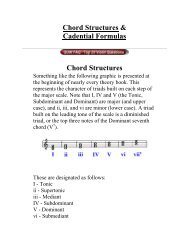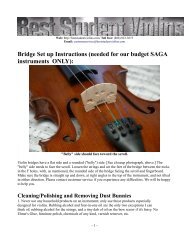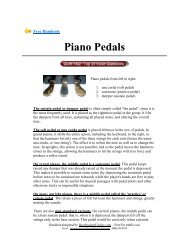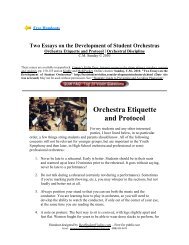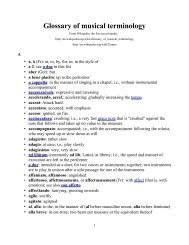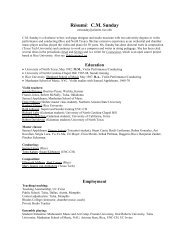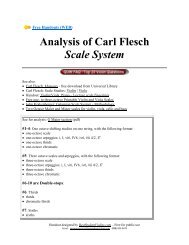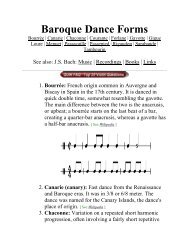Early History of the Violin (1520-1650) - Best Student Violins
Early History of the Violin (1520-1650) - Best Student Violins
Early History of the Violin (1520-1650) - Best Student Violins
You also want an ePaper? Increase the reach of your titles
YUMPU automatically turns print PDFs into web optimized ePapers that Google loves.
in <strong>the</strong> higher positions seems unlikely, considering <strong>the</strong> way <strong>the</strong> instrument was held in<br />
dance music. (From <strong>the</strong> modern viewpoint, second position is excellent to use, particularly<br />
in sequential passages.) However, <strong>the</strong>re was more to violin music than <strong>the</strong> extant pieces<br />
indicate. So much money was spent on fine instruments, and this is not compatible with <strong>the</strong><br />
idea <strong>of</strong> primitive instruments and technique. Orchestral and chamber parts were not required<br />
to go above <strong>the</strong> third position, but virtuoso pieces were ano<strong>the</strong>r matter. Some advance<br />
technique may have been lost because it was considered a pr<strong>of</strong>essional secret.<br />
After 1600, violin players built on <strong>the</strong> technical achievements <strong>of</strong> <strong>the</strong> viol players, and <strong>the</strong><br />
practice advanced rapidly. Monteverdi's operatic writing included idiomatic sections with<br />
comparatively sophisticated technique. After 1610, <strong>the</strong> advent <strong>of</strong> <strong>the</strong> violin sonata, <strong>the</strong><br />
formative period <strong>of</strong> violin practice ended and a new technical virtuosity came about in<br />
response to an age which produced Galileo, Kepler, Bacon, Descartes, Newton and Harvey.<br />
(And anticipated by da Vinci and manifested in <strong>the</strong> Reformation.) The rise <strong>of</strong> opera and<br />
instrumental forms not subordinate to <strong>the</strong> voice is analogous to <strong>the</strong> gradual subordination <strong>of</strong><br />
religious to secular authority. Musicians were usually lower-middle class, and traditionally<br />
from long lines <strong>of</strong> musical families; socially, <strong>the</strong> lot <strong>of</strong> <strong>the</strong> musician varied from little better<br />
than beggar to that <strong>of</strong> <strong>the</strong> Royal musicians, who enjoyed fine clo<strong>the</strong>s, salaries, and some<br />
measure <strong>of</strong> security. Even <strong>the</strong> ordinary musician was protected by unions in both France and<br />
England. During <strong>the</strong> early 17th century, <strong>the</strong> preeminence <strong>of</strong> violin making continued in<br />
Brescia and Cremona, and Biago Marini <strong>of</strong> Brescia (1597-1665) was <strong>the</strong> most important<br />
composer <strong>of</strong> violin music <strong>of</strong> <strong>the</strong> time; he and contemporaries such as Dario Castello,<br />
Salomone Rossi, Maurizio Cazzati, and Marco Uccellini experimented with purely<br />
instrumental forms. The sonata -- most advanced <strong>of</strong> instrumental forms -- came from <strong>the</strong> old<br />
practice <strong>of</strong> doubling vocal parts <strong>of</strong> a chanson, one <strong>of</strong> <strong>the</strong> principle Renaissance forms.<br />
Marini's work is calculated in terms <strong>of</strong> <strong>the</strong> violin; <strong>the</strong> rapid passages fit <strong>the</strong> hand,<br />
particularly in descending or ascending sequences and arpeggios and broken chords<br />
involving playing back and forth across strings. Marini used <strong>the</strong> "stile concitato," predating<br />
Monteverdi, and experimented extensively in double - and triple-stops. (Capriccio per<br />
Sonare il <strong>Violin</strong>o con tre corde a mondo di lira, Op. 8. ) His scordatura was written at pitch,<br />
leaving <strong>the</strong> player to work out <strong>the</strong> fingerings. (Most later scordatura works were written in<br />
"hand-grip" notation.)<br />
O<strong>the</strong>r special affects <strong>of</strong> <strong>the</strong> Baroque were <strong>the</strong> use <strong>of</strong> pizzicati like that used in Monteverdi's<br />
operas (not called such), <strong>the</strong> mute, col legno, sul ponticello and sulla tastiera. Harmonics<br />
may or may not have been known, and <strong>the</strong> matter is not settled. Two types <strong>of</strong> ornaments<br />
were used; (a) those with specific names, such as <strong>the</strong> trill, mordent, vibrato and (b) those<br />
which constituted some improvised melodic formulae. The practice <strong>of</strong> adding passages to<br />
<strong>the</strong> written score was so common that sometimes composers felt it was necessary to add<br />
"come sta senza passaggi." Since <strong>the</strong> demands <strong>of</strong> dance music were chiefly rhythmic, it is<br />
not known if violin practice included ornamental elaboration like <strong>the</strong> diminutions and<br />
passaggi <strong>of</strong> Francesco Rogniono. (Selva de varii passaggi secondo l'uso moderno. Milan,<br />
1620.)<br />
All <strong>of</strong> <strong>the</strong>se physical characteristics contributed to a sound which was altoge<strong>the</strong>r less



